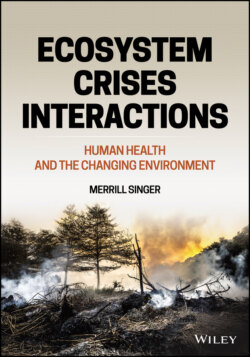Читать книгу Ecosystem Crises Interactions - Merrill Singer - Страница 37
2.3.1.2 Conceptualizing ecosystems
ОглавлениеAs an analytic concept, “ecosystem” was first used by the outspoken British botanist (and strong advocate of Freudian psychology) Arthur Tansley in 1935 (New Phytologist Foundation n.d.). Tansley, known as the father of British ecology, was the first president of the British Ecological Society and served as the initial editor of its Journal of Ecology. He developed the concept of the ecosystem to draw attention to traceable transfers and flows of energy (e.g., from the sun) and matter (e.g., nutrients, water) within specific geographic spaces. Ecosystems vary in size and complexity, and some scientists even view Earth as a single ecosystem. Ecosystem diversity references all the different habitats that exist on Earth, such as tropical or temperate forests, hot and cold deserts, wetlands, rivers, lakes and ponds, mountains and mountain valleys, caves, islands, shorelines, undersea kelp forests, coral reefs, hot springs, and deep‐ocean vents, plus many more. Matter and energy flow not only within ecosystems but between them as well (e.g., a river carries mater from land‐based to water‐based ecosystems), highlighting ecosystem interconnection.
Ecosystems are identifiable because they tend to maintain a natural balance among their component parts over time; that is, there is a state of dynamic equilibrium across their community of component organisms and a stability in the numbers of each species within them. This stability makes them recognizable even if identifiable changes occur (e.g., a beach ecosystem before and after a major storm). Ecological researchers have tried to develop general predictions about ecosystem community structure based on abiotic and biotic factors. Ecosystems, however, are not really static. They are impacted by various factors, including evolution, invasive species, salt intrusion, pollutants, overhunting, natural disasters, and global warming. Intrusive change in an ecosystem can be illustrated with the case of Walden Pond in Concord, Massachusetts, made famous by the environmentalist author Henry David Thoreau (2016). Walden Pond is what is called a kettle hole, a sediment‐bottomed shallow body of water. Created by glacial retreat, it is anchored by a beach and a surrounding wooded area. The detailed journal notes about the flora and fauna, weather, and seasons kept by Thoreau while living at Walden Pond from 1852 to 1858 have been used by modern scientists (Primack 2014; Stager et al. 2018) to show that because of climate change and other human influences, levels of phytoplankton have increased there, reducing water clarity, and ice on the surface now breaks up 2 weeks earlier than during his stay.
It has been found that ecosystems with higher biodiversity (a greater array of different lifeforms and genetic variations within species) tend to be more stable and to have greater resistance and resilience when faced with disturbances and disruptive events—an idea originally suggested by Darwin (Peterson et al. 1998). It is not easy in the short run to specify whether an ecosystem is disturbed (and could regain balance over time) or becoming a different, perhaps more degraded or simplified biotic/abiotic arrangement. Over longer periods of observation, however, it is evident that simplification occurs.
Ecosystems are different than habitats—another environmental term frequently used in this book. Habitats are the places where specific organisms live. Consequently, they exist everywhere on the planet, because organisms live everywhere. The Grand Canyon, for example, consists of multiple habitats, with cacti and warm desert scrub species living just above the Colorado River corridor, pinyon pine and junipers living above the desert scrub up to about 6000 feet above it, and abundant ponderosa pine living at even higher elevations. Other plant species and various animals also live in each of these habitats. Habitats exist in built environments as well, such as the tracks of the New York City subway, a habitat for the brown rat (Rattus norvegicus), as reflected in some of the popular names of this species (e.g., sewer rat, street rat). While ecosystem disruption refers to the loss of critical relationships, habitat disruption involves the loss of resources necessary for a species to live in a particular locale.
